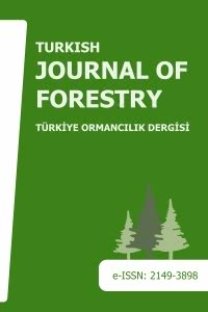Kağıt geri dönüşüm işlemlerinin selülozun yapısında meydana getirdiği değişimler üzerine bir inceleme
A study on paper recycling effects on cellulose properties
___
- Atalla, R.H. 1992. Structural Change in Cellulose during papermaking and Recycling. In: Rowell, et.al. Eds. Material Interaction Relevant to recycling of Wood-Based Material: Proceeding of Materials Research Society Symposium; 1992 April 27-29, San Francisco, CA.
- Attack, D. 1978. Advances in Beating and Refining. In : Fiber-Water Interaction in Papermaking. Wm. Clowes. London. p261.
- Bhat, G.R., Heitmann, J.A., Joyce, T.W., 1991. Novel Techniques for Enhanching the Strength Properties of Secondary Fiber. Tappi J.
- Biermann, C.J., 1993. Essentials of Pulping and Papermaking. Academic Press, Inc., San Diego.
- Brancato A.A., 2008. Effect of progresive recycling on cellulose fiber surface properties, Ph.D Theses, Georgia Institute of Tecnology. p112, USA.
- Carlson, G., Lindstrom, T., 1984. Hornification of Cellulosic Fibers During Wet Pressing. Svenk Papperstidning, No. 15: R119-R125.
- Clark, J. d'A., 1978. Pulp Technology and Treatment of Paper. Miller Freeman Publications, Inc. San Francisco.
- Corson, S.R. 1980. Fiber and Fines Fractions Influence Strength of TMP. Pulp & Paper Can., 81(5): 69.
- Ellis, R.L., Sedlachek, K.M., 1993. Recycled-Versus Virgin-Fiber Characteristic: A Comparison. In: Secondary Fiber Recycling. Spangenberg, R.J. Ed. Tappi Press. Atlanta, Georgia. p. 7.
- Fengel, D., Wegener, G., 1984. Wood; Chemistry, Ultrastructure, Reaction. Walter de Gruyter. Berlin.
- Giertz., H.W., 1962. In formation and structure of paper, Vol. 2, British Paper and Boards Makers Assoc., London, p. 619.
- Grignon, J., Scallan, A.M., 1980. Effect of pH and neutral salts upon the swelling of cellulose gels. Journal of Appl. Polym. Sci. Vol. 26: 2829-2843 p. D.H. 1983. Canadian Journal of pulp and paper 9 (1): Tr15.
- Gurnagul, N., 1995. sodium hyroxide addition during recycling; Effects on Fiber Swelling and Sheet Strength. Tappi J., 78(12): 119.
- Hartman, R.R. 1984. Mechanical Treatment of Pulp Fibres for Property Development, Doctoral Thesis. The Institute of Paper Chemistry, Appleton, USA.
- Higgins, H.G., McKenzie, A.W., 1963. The structure and properties of paper. XIV. Effect of Drying on Cellulose Fibers and The Problem of Maintaining Pulp Strength. Appita, 16(6): 145-164.
- Howard, R.C, Bichard, W., 1992. The Basic Effects of Recycling on Pulp Properties. Journal of Pulp and Paper Science, 18(4): J151.
- Howard, R.C. 1990. The Effect of Recycling on Paper Quality. Journal of Pulp and Paper Science: 16(5): 1990.
- Htun, M., de Ruvo, A., 1978. The Implication of the Fines Fraction for the Properties of Bleached Kraft Sheet. Svensk Papperstidning, 81(16): 507.
- Katz, S., Liebergott, N., Scallan, A.M., 1981. A Mechanism for the Alkali Strengthening of Mechanical Pulps. Tappi J. 64(7).
- Laivin, G.V., Scallan, A.M., 1996. The Influence of Drying and Beating on the Swelling of Fines. Journal of Pulp and Paper Science, 22(5): J178.
- McKee, R.C., 1971. Effect of Repulping on Sheet Properties & Fiber Characteristics. Paper Trade Journal, 155 (5): 34.
- Minor, J., 1994. Hornification. Its Origin and Meaning. Progress In Paper Recycling, 392: 93-95.
- Nanko, H., Asano, S., Ohsawa, J., 1991. Shrinking Behavior of Pulp Fibers During Drying. Tappi Proceeding, International Paper Physic Conference.
- Paavilainen, L., 1990. Importance of Particle Size, Fiber Length and Fines; for the Characterization of Softwood Kraft Pulp. Paperi ja Puu, 72(5): 516.
- Pazner, L., Behera, N.C., 1985. Beating Behavior and Sheet Strength Development of Conifer Organosolv Fibers. Holzforschung, 39(1): 51-61.
- Scallan, A.M., 1993. The effect of acidic groups on swelling of pulps-A review, Tappi Journal, 66 (11): 73-75.
- Scallan, A.M., Grignon, J.,. 1979. The Effect of Cations on Pulp and Paper Properties. Svensk Papperstidnink No. 2.
- Scallan, A.M., Tigerstorm, A.C.J., 1992. Swelling and elasticity of cell-walls of pulp fibers, Journal of Pulp and Paper Science, 18 (5): J188-J193.
- Scott, W.E., Abbott, J.E., 1995. Properties of paper: An introduction. (Eds.) Tappi Press, Atlanta, GA. 174p.
- Sjostrom, E., 1993. Wood Chemistry. Fundamentals and Applications. 2nd Ed., Academic Press, Inc., San Diego.
- Smook, G.A., 1994. Handbook for Pulp and Paper Technologists. Angus Wilde Publications, Canada, 419 pp.
- Spangenberg, R.J., 1993. Secondary fiber recycling, (Editor), Tappi Press, Atlanta, GA.
- Şahin, H.T. 2007. Kullanılmış atık kağıtların yeniden kağıt üretiminde kullanılması, Orman Mühendisliği Dergisi, 44 (3): Sayı 7-9.
- Üner B., Şahin H.T. 2004. Geri dönüşümde yaş pres ve kurutmanın lif özelliklerine etkisi, SDÜ Orman Fakültesi Dergisi, Seri-A, Sayı 1, s. 145-158.
- Walsh, F., 2006. An itopropic study of fiber-water interactions, Ph.D theses, Georgia Institute of Technology, 153p.
- Waterhouse, J.F., Liang, Y.X., 1995. Improving the Fines Performance of Recycling Pulps. Tappi Proceeding, 1995 Recycling Symposium.
- Wegner, T.H., 1982. Improve Strength in High-Yield Pulps Through Chemical Treatment. Tappi J., 65(8): 103.
- Wistara, N., Young, R.A., 1999. Properties and treatments of pulps from recycled paper. Part I. Physical and chemical properties of pulps. Cellulose, 6 (4): 291-324.
- Wistara, N., Zhang, X.J., Young, R.A., 1999. Properties and treatments of pulps from recycled paper. Part II. Surface properties and crystallinity of fibers and fines. Cellulose, 6 (4): 325-348.
- Young, R.A., 2008. Historical Developments in Wood Chemistry. SDU Faculty of Forestry Journal 2008; 1 (A): 1-15.
- ISSN: 1302-7085
- Yayın Aralığı: Yılda 2 Sayı
- Başlangıç: 2000
Kavak (Populus nigra x Populus deltoides) odunundan selüloz nanokristalit eldesi
Nilgül ÖZMEN, Nihat Sami ÇETİN, Nasır NARLIOĞLU
SERKAN GÜLSOY, ÖZDEMİR ŞENTÜRK, M. Güvenç NEGİZ
Eğilmeye çalışan budaklı kirişlerin sonlu elemanlar modelleri
Ergün GÜNTEKİN, TUĞBA YILMAZ AYDIN
Orman köylerinde kooperatifçiliğin gelişimine etki eden etmenler
HASAN ALKAN, MEHMET EMİN DEMİR
Yersel lazer tarama ile tek ağaç özelliklerinin belirlenmesi
Kastamonu'daki hastane bahçelerinin peyzaj tasarımlarının değerlendirilmesi
ÇİĞDEM SAKICI, Suzan ÇELİK, Özkan KAPUCU
Havasal LIDAR verileri kullanılarak meşcere parametrelerinin tahmin edilmesi
ALKAN GÜNLÜ, İLKER ERCANLI, Emin Zeki BASKENT, Muammer ŞENYURT
Kağıt üretiminde CaCO3 dolgu maddesinin kimyasal tutunması üzerine bir araştırma
